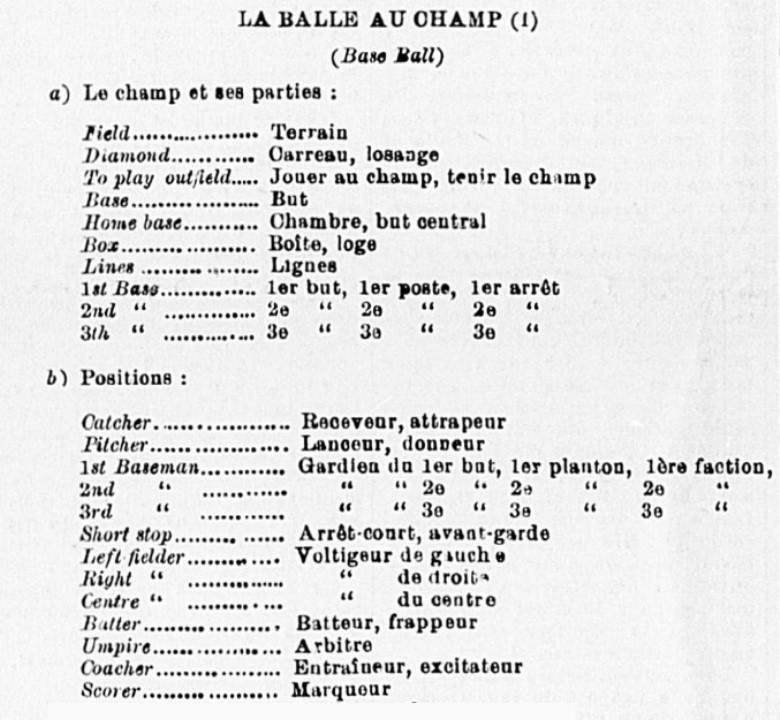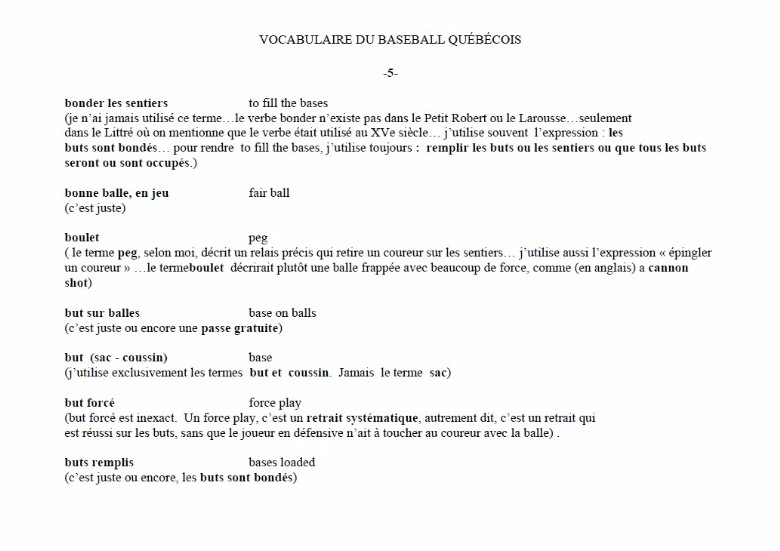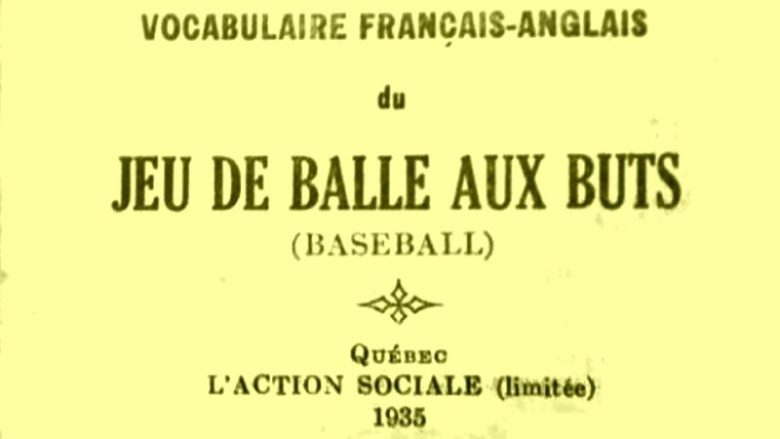Le chapitre de SABR-Québec s’est réuni le 25 janvier 2020 à Montréal à l’occasion de la journée SABR. Une seule présentation était à l’ordre du jour, offerte par deux de nos membres, tous deux historiens, soit Patrick Carpentier et Marcel Dugas, qui nous ont expliqué l’histoire de la francisation des termes de baseball au Québec.
La pratique du baseball au Québec remonte à 1869, et de 1880 à 1907 on peut parler d’une francisation anémique : les joueurs eux-mêmes utilisent les termes en anglais, la couverture de presse relativement marginale est truffée d’anglicismes, et le seul milieu qui pousse à l’usage du français est celui des collèges classiques, où les prêtres cherchent à défendre l’activité physique en français. Ainsi apparaissent des traductions directes comme premier-but, mais aussi des termes importés de France, où se jouait alors un jeu nommé la “Thèque”, apparenté aux “Rounders” britannique. Plusieurs de ces termes étaient calqués sur le vocabulaire militaire, comme celui de “voltigeur”. C’est aussi à cette époque qu’apparait le mot “arrêt-court” comme équivalent de “shortstop” mais son usage est encore nettement minoritaire. On trouve aussi des locutions plutôt bancales dans les sommaires, comme “frappé par balle lancée par le pitcher”.

Aperçu du premier lexique français du baseball publié au Québec. Courrier de Saint-Hyacinthe, 2 janvier 1909.
De 1908 à 1919, les premiers efforts de francisation systématique ont lieu avec le travail de la Société du bon parler français, et la publication lors de cette dernière année d’un dictionnaire visuel qui comprend de nombreux termes liés au baseball. On parle d’une francisation émergente, puisque l’anglais domine encore dans les compte-rendus écrits; cependant, le mot arrêt-court commence à prendre le dessus sur le terme anglais. On retrouve d’ailleurs régulièrement le même terme utilisé dans les deux langues dans un seul paragraphe d’un même article de presse.
De 1920 à 1934, le français prend finalement le dessus dans les médias, et les termes sont maintenant repris par les joueurs eux-mêmes. L’arrêt-court apparait maintenant deux fois plus fréquemment que le shortstop, et les articles deviennent beaucoup plus nombreux avec le retour des Royaux en 1928. En 1935, un guide terminologique du baseball est largement diffusé.
De 1934 à 1968, la francisation est presque complétée – dans les médias tout au moins. Les matchs sont diffusés à la radio à partir de 1935 et à la télévision en 1952, et les auditeurs se plaignent lorsqu’un commentateur a recours à des termes en anglais. Arrêt-court a gagné sa guerre, occupant 90% du terrain linguistique, et les linguistes dénoncent maintenant certains termes français abusifs, comme “empailleur”, une désignation toute phonétique de l’arbitre – l’umpire – qui n’a rien à voir avec la taxidermie !
La phase finale de la francisation aura lieu suite à l’arrivée des Expos en 1969. Nous avions la chance d’avoir parmi nous notre ami Jacques Doucet, commentateur des matchs de l’équipe à la radio, qui nous a expliqué comment certains termes qui manquaient à notre vocabulaire ont été créés à cette époque, tel que “prendre un coureur à contre-pied” ou encore un “coup frappé à l’entre-champ”. Toujours modeste, Jacques a cherché à minimiser son rôle dans ce travail. Nous savons tous à quel point il a contribué à faire que les termes français soient ceux utilisés par les instructeurs et les joueurs des petites ligues à cette époque.

Aperçu du vocabulaire du baseball québécois utilisé à la télévision en 2020 par le commentateur Jacques Doucet.
Cliquez ici pour télécharger le Vocabulaire du baseball de Jacques Doucet.
The Evolution of French Baseball Terms in Quebec
The SABR-Québec Chapter met on January 25, 2020 in Montreal for SABR Day. There was one topic on the agenda, a presentation by two of our members, Patrick Carpentier and Marcel Dugas, historians both, on the history of the introduction of French baseball terms in Quebec.
Baseball has been played in Quebec since the late 1860s, but from 1880 to 1907, one can speak of only an anemic presence of French terms to describe the game. The players themselves used only English terms, the rather marginal press coverage was chock-full of English words, and the only social group pushing for French terms was the church-run classical colleges, where the priests sought to defend the practice of sports in French. Some direct translations of English terms, such as “premier-but” for first base were introduced, but also some terms imported from France where a game called “La Thèque”, similar to British Rounders, was still played at the time. Many of these terms came from a military vocabulary, such as that for outfielder, “voltigeur” which originally means light-infantryman. It is also at that time that “arrêt-court” first appeared as a translation for shortstop, but its use was still marginal. There were also some rather clumsy formulations in game summaries, such as “frappé par balle lancée par le pitcher”, a very convoluted way to say hit-by-pitch.
From 1908 to 1919, the first attempts at a systematic translation of the game’s vocabulary appeared as a project of the “Société du bon parlé français” (Society for proper spoken French). In the last year of the period, a visual dictionary incorporating a large number of baseball terms was published. But the French vocabulary was still only emerging, as English terms still dominated game reports. Still, arrêt-court had now caught up with shortstop. A common feature of the era was to see both a French term and the English one used interchangeably in the same paragraph of a newspaper article.
From 1920 to 1934, French terms now predominated in media reports, and players themselves were starting to use them, as they became familiar with these. The arrêt-court was twice as common as the shortstop and newspaper articles were much more numerous with the return of the Montreal Royals in 1928. In 1935, a guide of French baseball terms was largely distributed throughout the province.
From 1934 to 1968, the move to French terms was almost completed – at least in the media. Games were broadcast on the radio starting in 1935 and on television in 1952, and listeners would phone in to complain when an announcer used too many English terms. Arrêt-court had won its war with shortstop, now appearing over 90% of the time, and linguists were starting to call out abusive use of French, such as “empailleur”, which literally means “taxidermist” but was often used as a phonetic equivalent of “umpire”, a usage which has since completely disappeared!
The arrival of the Expos in 1969 marked the final phase of the introduction of French terms. We were lucky to have with us Jacques Doucet, who broadcast the team’s games on the radio, and he explained to us how certain terms that were lacking were created at that time. These include “prendre un coureur à contre-pied” (picking off a runner) or “un coup frappé à l’entrechamp” (a Texas leaguer). Modest as always, Jacques sought to minimize his role in this work. We all know how much he contributed to the use of French terms among coaches and players in the Quebec little baseball leagues during that period.
This fascinating presentation, which was breaking new ground, was made even more dynamic thanks to the numerous period documents that our two presenters brought along. It was some remarkable research that illustrates what SABR does best – and therefore a perfect topic for SABR Day!

